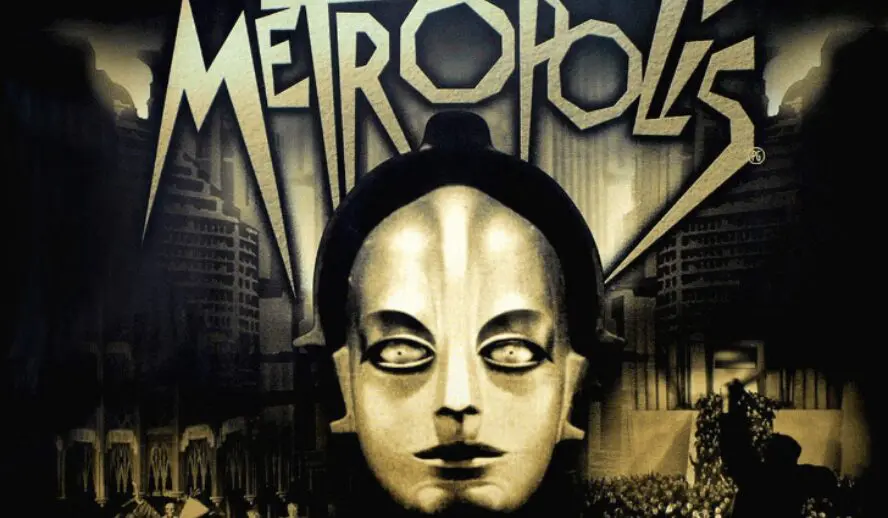Table of Contents

The most magical experience I’ve ever had watching a movie wasn’t in a regular movie theater. It used to be a movie theater, but today it’s the home of my hometown symphony: the beautiful Jacobs Music Center in downtown San Diego. Once a Fox Theatre movie palace, Jacobs maintains its 20s and 30s grandeur as a gorgeous destination for live orchestra and jazz, but also the occasional film screening with live music. In 2018, I got to see Russ Peck perform his own organ arrangement of the score for ‘Metropolis’, a silent science fiction epic of truly epic proportions by Austrian filmmaker Fritz Lang, accompanied by the film. I was truly star struck.
I made sure to get Peck’s autograph on my ticket after the show, and have been more than obsessed with this movie and broader film history ever since. There is something magical about old theater organs like the one at Jacobs and seeing films with live music, but ‘Metropolis’ is what made this experience truly memorable. Groundbreaking for its time in terms of visual effects and subject matter, it’s amazing just how far we’d come even in the earliest days of filmmaking. If you’ve never heard of this centerpiece of the German Expressionism movement in film, or even if you’re familiar with Fritz Lang’s work, dive in to learn more about the genesis of ‘Metropolis’ and its impact on film as an artform and an industry.
Things to do:
- Subscribe to The Hollywood Insider’s YouTube Channel, by clicking here.
- Limited Time Offer – FREE Subscription to The Hollywood Insider
- Click here to read more on The Hollywood Insider’s vision, values and mission statement here – Media has the responsibility to better our world – The Hollywood Insider fully focuses on substance and meaningful entertainment, against gossip and scandal, by combining entertainment, education, and philanthropy.
Utopias Are Built on Lies
‘Metropolis’ follows care-free Freder (Gustav Fröhlich), a citizen of the utopia Metropolis, as he discovers his world is built on shaky foundations. One day, he sees the beautiful Maria (Brigitte Helm) as she shows a group of poor workers’ children the wonders above ground. Enamored, he follows her into the underbelly of Metropolis, only to discover that his life of leisure is being enabled by thousands of suppressed workers toiling at the machinery of the city. One of the machines explodes, killing many workers and distressing Freder. He returns to his father Joh Fredersen (Alfred Abel), the head of this corrupt corporate utopia, who brushes off his son’s concerns and head machinist Grot’s (Heinrich George) evidence of rebellion brewing. In an act of righteousness, Freder returns to the underground to help the workers, assuming the identity of someone too ill to work and nearly dies at one of the machines himself.
Back above ground, Joh takes the maps Grot brought him to the mad inventor Rotwang (Rudolf Klein-Rogge) to decipher them. Rotwang, a man that once loved Joh’s eventual wife Hel, who died while giving birth to Freder, is constructing a robot to resurrect Hel, but decides to investigate the maps with his rival. In the catacombs of the undercity, they find Maria preaching to the masses that a mediator will act as the heart connecting the head, or the ruling class, with the hands, the working class of Metropolis. Unbeknownst to Joh, Freder is among the crowd and declares his love for Maria after everyone is gone. He volunteers to act as the mediator, pleasing Maria, then leaves again for the overworld.
WATCH THE TRAILER of the Film and the Revolution: ‘Can I Go Home Now?’
The Children Around the World Continue to Ask the question
Meanwhile, Joh has ordered Rotwang to kidnap Maria and give her likeness to the robot he is building, so that he can sow dissent between her and the workers and stop the revolution. Rotwang obliges, but only because he has something else in mind. When Freder finds Rotwang presenting the completed robot to Joh, he falls into despair, believing she and his father have both betrayed him. The false Maria, under Rotwang’s instruction, preaches to the workers that they must destroy the machines, the city, and the ruling class, to clear the way for Rotwang to usurp his rival Joh. Once recovered from his episode, Freder makes his way to the undercity to accuse the false Maria of being a fake, but it’s too late; the workers have destroyed the city’s machines and the underground begins to flood. The real Maria escapes from Rotwang’s lab and helps Freder save the workers’ children as the masses burn robot-Maria at the stake. Once again above ground, Rotwang snaps and chases Maria to the roof of the cathedral, believing she is Hel reincarnated. Freder fends him off, until Rotwang falls to his death, saving Maria. In the end, Freder and Maria preach that the classes must unite, and Freder links his father’s and Grot’s hands, fulfilling his prophesied role as the mediator and the heart of Metropolis.
Related article: – Want GUARANTEED SUCCESS? Remove these ten words from your vocabulary| Transform your life INSTANTLY
The Genesis of ‘Metropolis’
There is a lot to unpack in this synopsis, but we should start by looking under the hood of this film. ‘Metropolis’ was written by Lang’s wife Thea von Harbou, who collaborated with Lang frequently during the transition from silent to talking films. The movie took an obscene amount of time to shoot, hundreds of days and dozens of nights. Lang was a notoriously difficult director to work with, demanding near-perfection from his actors, but he found ways to justify his demands. ‘Metropolis’ was filmed during the Weimar era in Germany, a time of unprecedented economic and social turmoil in central Europe post-World War I. Thousands of adult extras and hundreds of kids worked on the film, one of few sources of paid creative work, though it was temporary and conditions were less than favorable. The children that worked on the film spent two weeks filming the flood of the undercity in a cold pool set, and many adult extras had to shave their heads and film outdoors in unrelenting sun. Lang also insisted on practical effects, meaning Helm’s costume caught on fire as they filmed the robot being burned at the stake. The budget also ballooned out of control as production dragged on, getting producers fired and distressing Universum-Film Aktiengesellschaft, or UFA, during its brief period free of government control (UFA began as a government-backed film studio in the teens, was independent during the twenties, but was integrated into the Nazi regime as a propaganda tool in the thirties… the history here runs much deeper, but that’s the short version).
Related article: EVOLUTION: Every Ryan Gosling Role From 1995 to 2020, All Performances Exceptionally Poignant
Related article: EVOLUTION: Every Henry Cavill Role From 2001 to 2021, All Performances Exceptionally Poignant
Related article: 23 Female Filmmakers That Have Succeeded in an Industry of Men
The Beginning of Movie Magic
Special effects play a huge role in this film, and it being the early days of artistic film meant Lang and his co-creatives needed to, well, be creative. ‘Metropolis’ was made pre-travelling matte process, better known as green screen technology, so the visual effects visionary behind the movie magic of this film Eugen Schüfftan pioneered what became known as the Schüfftan Process. A mirror would be set up directly in front of the camera, and the reflective coating on the back would be scratched off meticulously to show the actors/scene through the glass. The sections left alone would reflect artwork or other action going behind the camera, simultaneously capturing the scene and scenery at the same time, rather than engineering the effect in post. Miniature models of the city of Metropolis are also used throughout the film, with moving vehicles and painted vistas of the Tower of Babel-inspired center of the city in front of real but tiny buildings. The robot costume worn by Helm was also a technical marvel, making use of brand new material engineering to mold the suit to her (though it was still stiff and painful to wear). Particular attention was paid to the music that would accompany the film in theaters. Gottfried Huppertz wrote the score using inspiration from some of the biggest European composers and incorporating familiar themes and tones from religious music, namely the ‘Dies Irae’, a part of Gregorian chant used in Catholic funeral masses that elicits darkness and danger that can be heard in hundreds of film scores today.
Related article: Understanding the Star Wars Timeline
Related article: A Tribute to Francis Ford Coppola: One of Cinema’s Unforgettable Directors | ‘Megalopolis’, ‘The Godfather’ & More
Related article: #metoo Revolution: Powerful Questions That Need Answers
Related article: FACT-CHECKED Series: Timothee Chalamet and 32 Facts about The Young Superstar
Related article: Influencer Coogan Laws: Jackie Coogan in the Digital Age
The Real Trouble Begins
The film was finally completed in 1926, but the turmoil didn’t stop there. Upon its premiere in Berlin in 1927, critics lauded it as a technical marvel but a story flop, and distributors began editing for subsequent releases abroad. Various versions were exported to the UK and the US, eliminating entire plot points and bringing the run-time under two hours. Lang was appalled by this, but Paramount and MGM, the contracted American distributors, claimed the right to make any edits they deemed necessary to ensure profitability. In Germany, Nazi censors eventually demanded edits as well to tone down the religious imagery and communist undertone. Because of this, much of what ended up on the cutting room floor in post-release edits was thought to be lost for decades. More on the film’s restoration later, but despite enforcing censorship of parts of the film in Germany, Nazi propagandist Joseph Goebbels loved the movie, and later invited Lang to join the propaganda mobilization within Germany leading into World War II. Lang and his family were Jewish, and though the following anecdote was most likely embellished by Lang, he describes telling Goebbels he would consider the offer, but fled the country for Paris the same night, eventually ending up in the US. Naturally, Lang abhorred the Nazi regime, given his background and the subject matter of his films, especially that of ‘Metropolis’.
Related article: Top 10 South Park Characters | Who Makes the Cut? Kenny, Chef, Butters, Towelie, Eric?
Related article: In-Depth Analysis | The Unexpected Queerness of ‘Bob’s Burgers’: Why the Show is an Animated Ally
Related article: Are In-Person Experiences the Next Streaming Wars? What is Netflix House?
In the Fullness of Time
Various edits meant huge chunks of footage went missing in the early days of the film’s existence. Major restoration efforts were made in the 70s, 80s, and early 2000s, but in 2008, a 16 mm backup print of Lang’s complete ‘Metropolis’ was discovered in the archive of the Museo del Cine in Buenos Aires, Argentina, obtained from a distributor’s collection who had gotten the print in advance of screenings for the original release in South America. This was nothing short of a miracle, even though the print was extremely old and damaged, but it made it possible for viewers to see the full film as Lang intended today. The original score was also finally recorded for the first time in its totality in the 2000s, and could be reunited with the original iteration of the movie. Opinions have changed about Lang’s masterpiece in the nearly 100 years since its premiere, being lauded by modern critics as both a feat of technical magic and having a message more relevant than ever. Sci-fi as we know it straight up would not exist without this film. It wasn’t the first, but it’s one that has stood the test of time and inspired so many other works of science fiction, fantasy, futurism, and unbridled imagination with something to say about the world as it is and what it can be. ‘Metropolis’ became the first film inscribed in UNESCO’s Memory of the World register, cementing its importance in film and science fiction history.
Related article: In-Depth Analysis | The Unexpected Queerness of ‘Bob’s Burgers’: Why the Show is an Animated Ally
Related article: EVOLUTION: Every Chris Evans Role From 1997 to 2020, All Performances Exceptionally Poignant
Related article: Release Dates for the 2024 Cannes Film Festival’s Most Hyped Movies
The ‘Megalopolis’ in the Room
If you’ve seen, heard about, or read my review of Francis Ford Coppola’s ‘Megalopolis’, you most likely heard echoes of how people talk about his latest film in this deep dive into Lang’s ‘Metropolis’. Hugely over budget productions, ridiculous runtimes, critical pans upon release, enormous spectacles at the expense of story, all that is missing is studio intervention in the final edit, but only because Coppola self-financed and distributed his $120M+ behemoth. I wanted to like ‘Megalopolis’ so badly, because it is inspired by and was pitched as a fable in the world of ‘Metropolis’, and there are some common themes between the two, but there was something off. CGI doesn’t scratch the same itch that early special effects do, and there is something so strange about the pacing and storytelling in Coppola’s latest project. We may only know in the fullness of time whether ‘Megalopolis’ will see the critical acclaim down the road Coppola seems to think it deserves and that Lang eventually got for his initially misunderstood epic. Is Coppola ahead of his time? Lang certainly was. Check in again in 97 years, and someone may have an answer.
Click here to read The Hollywood Insider’s CEO Pritan Ambroase’s love letter to Cinema, TV and Media. An excerpt from the love letter: The Hollywood Insider’s CEO/editor-in-chief Pritan Ambroase affirms, “We have the space and time for all your stories, no matter who/what/where you are. Media/Cinema/TV have a responsibility to better the world and The Hollywood Insider will continue to do so. Talent, diversity and authenticity matter in Cinema/TV, media and storytelling. In fact, I reckon that we should announce “talent-diversity-authenticity-storytelling-Cinema-Oscars-Academy-Awards” as synonyms of each other. We show respect to talent and stories regardless of their skin color, race, gender, sexuality, religion, nationality, etc., thus allowing authenticity into this system just by something as simple as accepting and showing respect to the human species’ factual diversity. We become greater just by respecting and appreciating talent in all its shapes, sizes, and forms. Award winners, which includes nominees, must be chosen on the greatness of their talent ALONE.
I am sure I am speaking for a multitude of Cinema lovers all over the world when I speak of the following sentiments that this medium of art has blessed me with. Cinema taught me about our world, at times in English and at times through the beautiful one-inch bar of subtitles. I learned from the stories in the global movies that we are all alike across all borders. Remember that one of the best symbols of many great civilizations and their prosperity has been the art they have left behind. This art can be in the form of paintings, sculptures, architecture, writings, inventions, etc. For our modern society, Cinema happens to be one of them. Cinema is more than just a form of entertainment, it is an integral part of society. I love the world uniting, be it for Cinema, TV, media, art, fashion, sport, etc. Please keep this going full speed.”
More Interesting Stories From The Hollywood Insider
– Want GUARANTEED SUCCESS? Remove these ten words from your vocabulary| Transform your life INSTANTLY
– A Tribute to Martin Scorsese: A Complete Analysis of the Life and Career of the Man Who Lives and Breathes Cinema
– Do you know the hidden messages in ‘Call Me By Your Name’? Find out behind the scenes facts in the full commentary and In-depth analysis of the cinematic masterpiece
– A Tribute To The Academy Awards: All Best Actor/Actress Speeches From The Beginning Of Oscars 1929-2019 | From Rami Malek, Leonardo DiCaprio To Denzel Washington, Halle Berry & Beyond | From Olivia Colman, Meryl Streep To Bette Davis & Beyond
– In the 32nd Year Of His Career, Keanu Reeves’ Face Continues To Reign After Launching Movies Earning Over $4.3 Billion In Total – “John Wick”, “Toy Story 4”, “Matrix”, And Many More

Abigail Whitehurst is an entertainment professional and writer for Hollywood Insider based in Los Angeles, CA. Having lived all over the world as part of a military family and having pursued a bachelors of music, she brings a unique outlook to the entertainment industry. A life-long learner and researcher, Abigail is pursuing her masters in entertainment management. She strives to write through the lenses of context, analysis, and Hollywood Insider’s values to bring a fresh perspective to industry trends, entertainment business, and new film and TV releases. Her favorite place is a movie theater, and she’s always hunting for the deeper meaning and studying media as it pertains to culture. Film, TV, and interactive media are some of the most impactful artforms of our day, and they are worth digging into and analyzing. Everything is connected, whether it’s through Bacon numbers or history. When she’s not writing or at the movies, you can find Abbie crocheting or playing video games with her partner.








